How to restore an old cast-iron bath: a comparative review of the 3 best ways
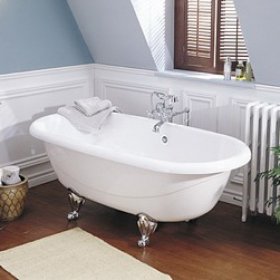
Sooner or later, the enamel of any bathtub becomes thinner, indelible rusty stains appear on it, and its owner with chagrin notes that it is time to change the equipment. This difficult procedure is very time-consuming, so many are trying to figure out how to update an old cast-iron bath and whether this is possible at all. Despite the fact that the appearance of such a device leaves much to be desired, the design fully retains all its operational characteristics. Therefore, restoration should only consist in applying a new enamel coating. Modern technology allows us to do this.
Content
Is it worth restoring old equipment?
The most obvious solution is replacing plumbing equipment. Let's try to figure out how much such an event will result in. To the cost of the simplest bath we add the costs of its transportation, lifting the device to the floor, if necessary. In addition, a certain amount will be required to pay for the dismantling of old equipment and the installation of new ones. At the lowest prices, all this will require about 12,000 rubles. This is only in the case when the wall and floor covering will not be damaged during installation. Otherwise, you will also have to pay for a partial bathroom repair.
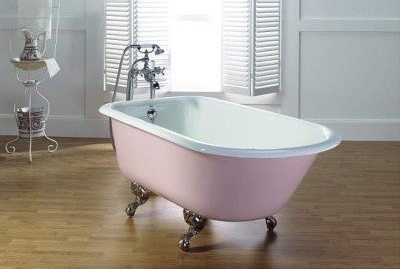
Dismantling the old and installing a new bath is a troublesome and costly undertaking. If the enamel of the equipment is thinned or washed off, and the device itself is still in good condition, it is worth considering restoration
Thus, for a fairly large amount, we get a modest result, since the calculation of the cost of the cheapest bath was laid. If you want a more convenient or high-quality design, you will have to increase the estimated cost item. Not everyone can afford such costs, so they want to restore their cast-iron bath. This is a cheaper and more effective solution.
However, it is very important to correctly choose the method of restoration. There are only three of them:
- acrylic bath coating;
- applying a new layer of enamel on the surface of the device;
- installation of an acrylic liner.
Let's consider each method in more detail.
What restoration methods exist?
Option # 1 - Acrylic Coating
Restoration of a cast-iron bath by the method of "pouring" acrylic is considered one of the simplest. This is a fairly new method that has managed to gain popularity among consumers. It consists in applying a liquid solution of acrylic by pouring onto the surface of the equipment. Among its advantages include:
- Durability. The coating obtained in this way, subject to its competent application, retains its properties for about 8-15 years.This is due to the fact that acrylic is applied with a sufficiently thick layer of about 6 mm.
- Smooth glossy finish. The composition is quite thick. It spreads well over the surface of the device, filling in possible irregularities, forming an almost perfectly flat and smooth plane.
- Relative simplicity and high speed of applying liquid acrylic.
- The absence of an unpleasant smell, which allows you to perform work even in homes where allergy sufferers, children and the elderly live.
There are also disadvantages to the method. These include the drying time of the composition. This usually takes about three days, during which it is not recommended even to approach the device. Because debris, dust particles or water that accidentally spills onto a drying surface can ruin it.
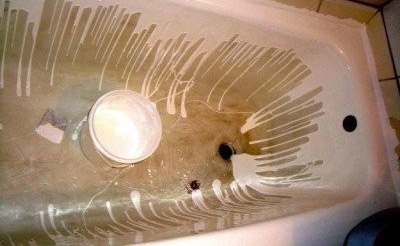
Despite the apparent simplicity of applying acrylic by the filling method, this is a rather complicated way of restoration. Certain composition skills required
Another negative point is the relatively high cost. It is higher than enameling. However, such a price is justified by a longer service life and good coating quality.
Option # 2 - self-enameling
The oldest way to restore. It remotely resembles painting, but you need to clearly understand what is applied in this case, special enamel. It is her who needs to be chosen, wondering how to paint a cast-iron bath. There are two types of such compositions: for professional application and for independent. The first ones are very liquid and require laying in several layers. This is a rather complicated procedure. The second ones are thicker and, accordingly, easier to apply.
A correctly selected composition with the help of a roller, and more often a brush, is laid on the prepared surface of the equipment. Advantages of this method:
- The cheapest option for restoration.
- There is no need for dismantling and subsequent installation of the drain and overflow.
- Suitable for both cast iron and steel bathtubs.
The disadvantages of enameling are much greater:
- The service life of the new enamel is about 5 years.
- The composition deposited on the surface of the equipment dries for a long time - about 5-7 days.
- The coating is hard, respectively, very sensitive to shock. Over time, the appearance of chips is possible.
- Enamel is applied with a sufficiently thin layer, therefore it is not able to cover various surface irregularities such as dents, chips, etc.
- Over time, the epoxy coating necessarily turns yellow.
It must be understood that the enamel obtained as a result of restoration is seriously different from that which was originally applied to the equipment.

Cold enameling is the cheapest and easiest way to restore. It resembles painting a surface with a special composition.
To enamel last as long as possible, you should follow simple rules. For example, to wash an updated cast-iron bath you will need not an abrasive powder, but a mild soap solution. Otherwise, the enamel will be damaged. The device should be protected from shock, especially with sharp objects, and do not pour too hot water into it. When filling the tank, first open the tap with cold water and only then with hot water.
Option # 3 - “bath to bath” method
This is the name of the restoration method, which consists in installing an acrylic liner completely repeating its contours inside the old structure. The insert is mounted on a special adhesive foam. With competent work, the bath service life after restoration is about 15 years. The main advantages of the method:
- The strength of the new coating. Acrylic is much stronger than enamel.
- Smooth surface hiding all defects of the old design.
- The surface will not turn yellow over time.
- A successful combination of the advantages of acrylic and cast-iron bathtubs.
The disadvantages of the method can be considered the need to dismantle the drain siphon and the ban on the installation of inserts in thin structures, which are called "from light cast iron" or "thin cast iron". This is due to the fact that the equipment can bend and the adhesive layer securing the liner will be broken. The “bath to bath” method is very demanding on the quality of materials. Using a poor quality insert or improper glue, the bath cannot be restored.
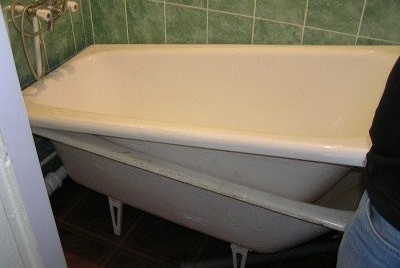
Installing an acrylic liner is a simple and effective restoration method. Particular attention should be paid to the size of the insert. It should perfectly match the bath
All three methods require preparation of equipment for upgrade. This step usually involves cleaning the cast iron bath from dirt and grease. Degreasing is done with oxalic acid or baking soda. All defects are thoroughly cleaned so that the surface is even. Then grinding is carried out. The result should be a rough surface. When applying the desired composition to it, the adhesion with it will be maximum.
To restore or not - objective conclusions
The decision to restore or replace the old bath, of course, will be its owner. However, you need to know that if you correctly carry out restoration work and use only high-quality materials, the updated bath will last a long time. Perhaps it is worth entrusting this task to experienced professionals with a good reputation. Then for relatively little money you can get an excellent result.

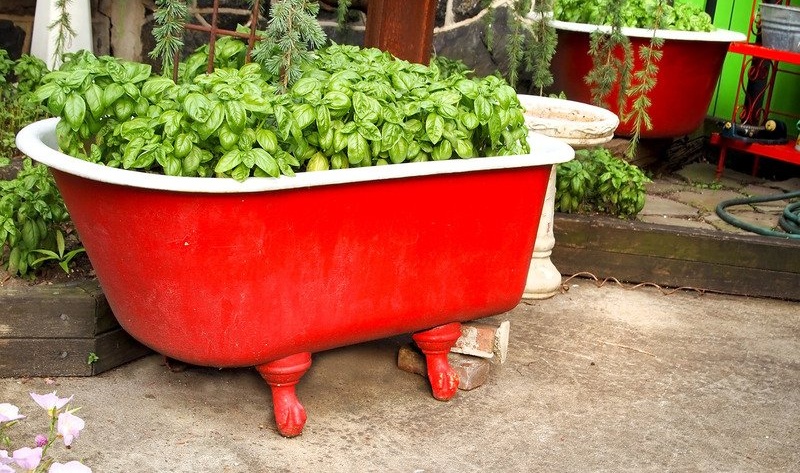
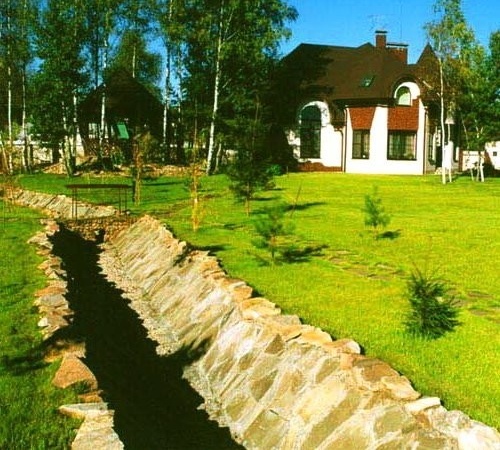
4 comments